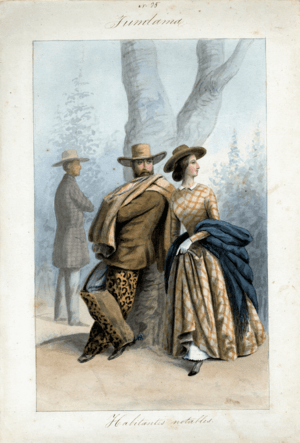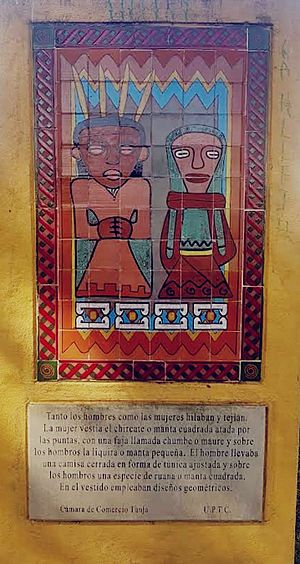Ruana facts for kids
A ruana is a special type of outer clothing, like a poncho, that comes from the Andes mountains in Colombia and Venezuela. It's a traditional piece of clothing, especially in the Boyacá region of Colombia. People in areas like Cundinamarca, Antioquia, and Nariño also wear them. In Venezuela, ruanas are common in the Andean states of Táchira, Mérida, and Trujillo. They have been worn since colonial times.
A ruana looks like a thick, soft, square or rectangular blanket. It has a hole in the middle for your head. There's also a slit down the front. Some ruanas even have a hood to cover your head.
Contents
What's in a Name?
No one is completely sure where the word "ruana" comes from. Some people think it's from the Spanish word ruana, which can mean "ragged" or "woolen cloth." Others believe it comes from the Quechua language.
Another idea is that the name came from cloths that the Spanish brought from a place called Rouen in France. Some also think it might come from the Chibcha language. In Chibcha, ruana might have meant "Land of Blankets." This could refer to the wool fabrics made by the Muisca and Timoto-cuica people long ago.
History of the Ruana
People like the Muisca (also known as Chibcha) wore clothes similar to the ruana before the Spanish arrived.
The ruanas worn by the Muisca people were likely made of wool. They were long, reaching to the knees. These were perfect for the cold weather in their region. They used ruanas not just as clothes, but also as blankets for sleeping or sitting on. Many ruanas today are still handmade from pure sheep's wool.
Some experts believe that the modern ruana didn't really come from these old clothes. They think it was brought in after the Spanish took over. This might have happened when Quechua people, who were servants, were brought from the Inca Empire to work the land.
Ruanas in Colombia

In Colombia, the ruana is very important. There are even two festivals that celebrate it! Both are in the Boyacá region. One is the World Day of Ruana in Nobsa. The other is the National Festival of Ruana in Paipa.
This special garment is also a big part of a type of folk music called Carranga. This music started in the countryside of Boyacá. It often uses instruments like the Tiple and Guitar.
Boyacá and Cundinamarca
The Boyacá and Cundinamarca regions are known for their ruanas. These areas have a strong connection to this traditional clothing.
Antioquia
In the Antioquia region, the ruana was a common part of farmers' clothing. They also wore things like espadrilles (shoes), hats, and a special bag called a Carriel. Ruanas from Antioquia are usually made of sheep's wool and are dark in color. They used to have big red and yellow stripes. Now, they are often simpler, with black, dark blue, or dark gray being very common.
Caldas
In the Caldas region, ruanas are a mix of the Antioquia and Boyacá styles. This is because people from both regions settled there over time. Ruanas are popular in cold towns like Marulanda and Manzanares. They are also worn in high mountain areas near Nevado del Ruiz.
Ruanas in Venezuela
In Venezuela, the ruana is a typical outfit in the Mérida mountain range. It's a special part of the clothing for people from that area. Long ago, people all over Venezuela used ruanas or blankets. They wore them to protect themselves from the sun in hot places or from the cold in high areas.
One writer, Ramón Páez, said that people used a thick wool blanket. This kept them cool during the day and warm at night. He mentioned that they often wore a double blanket, which could be turned inside out. It might have been dark blue on one side and red on the other. They would wear the blue side out on humid days and the red side out on sunny days.
In the Venezuelan Andes, everyone wore ruanas. A German painter named Ferdinand Bellermann was very interested in this. Back then, ruanas were usually one color. In the Andes, they were handmade from animal fabrics to keep warm. In the plains, they were lighter to protect from the heat. Today, ruanas are not worn every day as much. They are mostly worn for cultural events or in the higher parts of the Mérida mountains.
Images for kids
See also
 In Spanish: Ruana para niños
In Spanish: Ruana para niños










